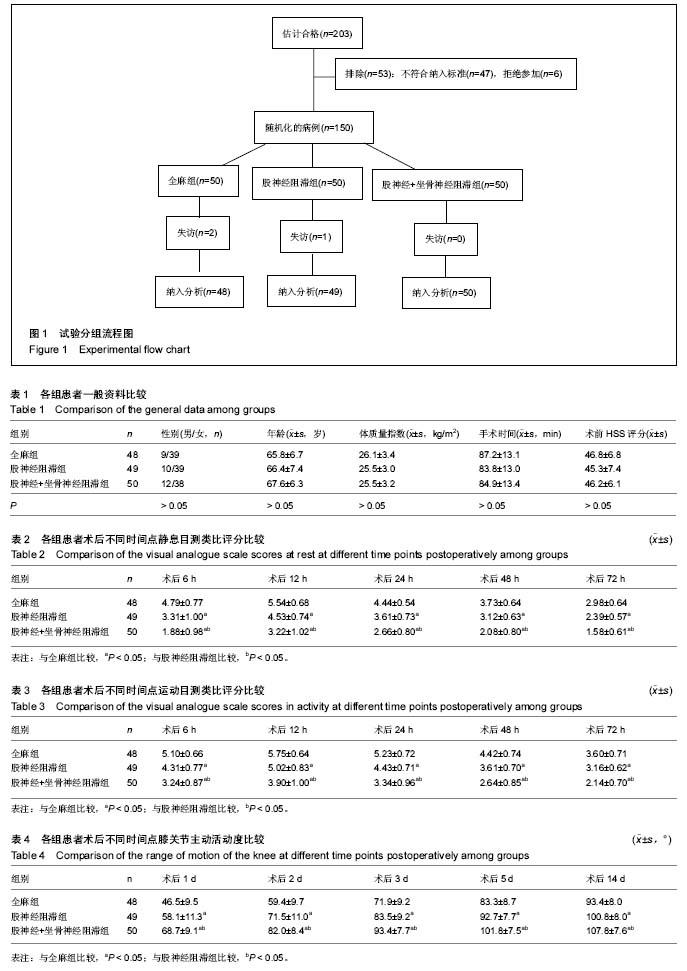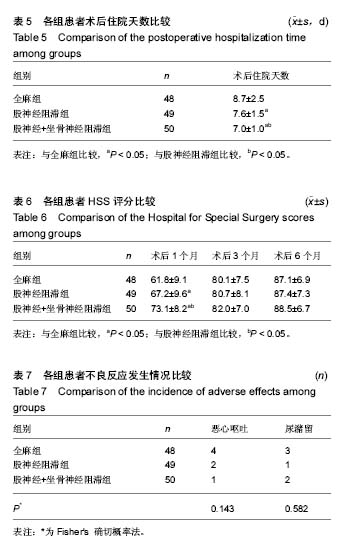| [1] Lungu E, Vendittoli PA, Desmeules F. Preoperative Determinants of Patient-reported Pain and Physical Function Levels Following Total Knee Arthroplasty: A Systematic Review. Open Orthop J. 2016;10: 213-231.[2] Shin HJ, Soh JS, Lim HH, et al. In-plane three-step needle insertion technique for ultrasound-guided continuous femoral nerve block after total knee arthroplasty: a retrospective review of 488 cases. Korean J Anesthesiol. 2016; 69(6): 587-591.[3] Albrecht E, Morfey D, Chan V, et al. Single-injection or continuous femoral nerve block for total knee arthroplasty? Clin Orthop Relat Res. 2014; 472(5): 1384-1393.[4] Jakobsen TL, Kehlet H, Husted H, et al. Early progressive strength training to enhance recovery after fast-track total knee arthroplasty: a randomized controlled trial. Arthritis Care Res (Hoboken). 2014; 66(12): 1856-1866.[5] Grosu I, Thienpont E, De Kock M, et al. Dynamic view of postoperative pain evolution after total knee arthroplasty: a prospective observational study. Minerva Anestesiol. 2016; 82(3): 274-283.[6] Baratta JL, Gandhi K, Viscusi ER. Perioperative pain management for total knee arthroplasty. J Surg Orthop Adv. 2014; 23(1): 22-36.[7] Burns LC, Ritvo SE, Ferguson MK, et al. Pain catastrophizing as a risk factor for chronic pain after total knee arthroplasty: a systematic review. J Pain Res. 2015; 8: 21-32.[8] Aveline C, Roux AL, Hetet HL, et al. Pain and recovery after total knee arthroplasty: a 12-month follow-up after a prospective randomized study evaluating Nefopam and Ketamine for early rehabilitation. Clin J Pain. 2014; 30(9): 749-754.[9] Lewis GN, Rice DA, McNair PJ, et al. Predictors of persistent pain after total knee arthroplasty: a systematic review and meta-analysis. Br J Anaesth. 2015; 114(4): 551-561.[10] 杨礼庆,马超,杜帅. 人工全膝关节置换术围手术期疼痛管理现状[J]. 中国矫形外科杂志,2017,25(3): 247-250.[11] Lewis C, Gunta K, Mitchell K, et al. Effectiveness of multimodal pain management protocol in total knee arthroplasty patients. Orthop Nurs. 2012;31(3):153-159.[12] Lamplot JD, Wagner ER, Manning DW. Multimodal pain management in total knee arthroplasty: a prospective randomized controlled trial. J Arthroplasty. 2014; 29(2): 329-334.[13] Moore A, Makinson G, Li C. Patient-level pooled analysis of adjudicated gastrointestinal outcomes in celecoxib clinical trials: meta-analysis of 51,000 patients enrolled in 52 randomized trials. Arthritis Res Ther. 2013; 15(1): R6.[14] Leese PT, Hubbard RC, Karim A, et al. Effects of celecoxib, a novel cyclooxygenase-2 inhibitor, on platelet function in healthy adults:a randomized, controlled trial.J Clin Pharmacol. 2000;40:124-132.[15] Huang YM, Wang CM, Wang CT, et al. Perioperative celecoxib administration for pain management after total knee arthroplasty-a randomized, controlled study. BMC Musculoskelet Disord. 2008; 9: 77.[16] Mammoto T, Fujie K, Mamizuka N, et al. Effects of postoperative administration of celecoxib on pain management in patients after total knee arthroplasty: study protocol for an open-label randomized controlled trial. Trials. 2016; 17: 45-51.[17] Chloropoulou P, Iatrou C, Vogiatzaki T, et al. Epidural anesthesia followed by epidural analgesia produces less inflammatory response than spinal anesthesia followed by intravenous morphine analgesia in patients with total knee arthroplasty. Med Sci Monit. 2013; 19: 73-80.[18] 刘艳,刘海林.连续股神经阻滞与静脉自控对全膝关节置换的镇痛效果比较[J].中国组织工程研究, 2015,19(48): 7736-7740.[19] Tang Q, Li X, Yu L, et al. Preoperative ropivacaine with or without tramadol for femoral nerve block in total knee arthroplasty. J Orthop Surg (Hong Kong). 2016; 24(2): 183-187.[20] Cip J, Erb-Linzmeier H, Stadlbauer P,et al. Continuous intra-articular local anesthetic drug instillation versus discontinuous sciatic nerve block after total knee arthroplasty. J Clin Anesth. 2016; 35: 543-550.[21] Nader A, Kendall MC, Manning DW, et al. Single-dose adductor canal block with local infiltrative analgesia compared with local infiltrate analgesia after total knee arthroplasty: a randomized, double-blind, placebo-controlled trial. Reg Anesth Pain Med. 2016; 41(6): 678-684.[22] Macrinici G, Drescher M, Ascan J, et al. Poster 391 Prospective, Double-blind, Randomized Clinical Trial to Compare Single Shot Adductor Canal Nerve Block Versus Femoral Nerve Block Combined with Local Infiltration Analgesia: Postoperative Functional Outcomes After Total Knee Arthroplasty. PM R. 2016; 8(9S): S288-S289.[23] 康鹏德,王浩洋,沈彬,等. 加入局部浸润镇痛的多模式镇痛在全膝关节置换中的应用[J].中华骨科杂志, 2013,33(3):246-251.[24] Schinsky MF, McCune C, Bonomi J. Multifaceted comparison of two cryotherapy devices used after total knee arthroplasty: cryotherapy device comparison. Orthop Nurs. 2016; 35(5): 309-316. [25] Wang F, Zhou Y, Sun J, et al. Influences of continuous femoral nerve block on knee function and quality of life in patients following total knee arthroplasty. Int J Clin Exp Med. 2015; 8(10): 19120-19125.[26] Peng L, Ren L, Qin P, et al. Continuous femoral nerve block versus intravenous patient controlled analgesia for knee mobility and long-term pain in patients receiving total knee replacement: a randomized controlled trial. Evid Based Complement Alternat Med. 2014; 2014: 569107.[27] Kinjo S, Lim E, Sands LP, et al. Does using a femoral nerve block for total knee replacement decrease postoperative delirium? BMC Anesthesiol. 2012; 12: 4.[28] Wegener JT, van Ooij B, van Dijk CN, et al. Long-term pain and functional disability after total knee arthroplasty with and without single-injection or continuous sciatic nerve block in addition to continuous femoral nerve block: a prospective, 1-year follow-up of a randomized controlled trial. Reg Anesth Pain Med. 2013; 38(1): 58-63.[29] Sato K, Adachi T, Shirai N, et al. Continuous versus single-injection sciatic nerve block added to continuous femoral nerve block for analgesia after total knee arthroplasty: a prospective, randomized, double-blind study. Reg Anesth Pain Med. 2014; 39(3): 225-229.[30] Akkaya A, Tekelioglu UY, Demirhan A, et al. Ultrasound- guided femoral and sciatic nerve blocks combined with sedoanalgesia versus spinal anesthesia in total knee arthroplasty. Korean J Anesthesiol. 2014; 67(2): 90-95.[31] Carvalho Júnior LH, Temponi EF, Paganini VO, et al. Reducing the length of hospital stay after total knee arthroplasty: influence of femoral and sciatic nerve block. Rev Assoc Med Bras (1992). 2015; 61(1): 40-43.[32] Jules-Elysee KM, Wilfred SE, Memtsoudis SG, et al. Steroid modulation of cytokine release and desmosine levels in bilateral total knee replacement: a prospective, double-blind, randomized controlled trial. J Bone Joint Surg Am. 2012; 94(23): 2120-2127.[33] Jianda X, Yuxing Q, Yi G, et al. Impact of preemptive analgesia on inflammatory responses and rehabilitation after primary total knee arthroplasty: a controlled clinical study. Sci Rep. 2016; 6: 30354.[34] Gwam CU, Mistry JB, Richards IV, et al. Does Addition of Adductor Canal Blockade to Multimodal Periarticular Analgesia Improve Discharge Status, Pain Levels, Opioid Use, and Length of Stay after Total Knee Arthroplasty? J Knee Surg. 2017. doi: 10.1055/s-0037-1602131. [Epub ahead of print][35] Pinsornsak P, Nangnual S, Boontanapibul K. Multimodal infiltration of local anaesthetic in total knee arthroplasty; is posterior capsular infiltration worth the risk? a prospective, double-blind, randomised controlled trial. Bone Joint J. 2017;99-B(4):483-488. [36] Koh HJ, Koh IJ, Kim MS, et al. Does Patient Perception Differ Following Adductor Canal Block and Femoral Nerve Block in Total Knee Arthroplasty? A Simultaneous Bilateral Randomized Study. J Arthroplasty. 2017;32(6):1856-1861.[37] Gwam CU, Mistry JB, Jha P, et al. Efficacy of Adductor Canal Blockade Compared to Multimodal Peri-Articular Analgesia Following Total Knee Arthroplasty. Surg Technol Int. 2017;30. pii: sti30/804. [Epub ahead of print][38] Gwam CU, Mistry JB, Khlopas A, et al. Does Addition of Multimodal Periarticular Analgesia to Adductor Canal Block Improve Lengths of Stay, Pain, Discharge Status, and Opioid Use After Total Knee Arthroplasty? J Arthroplasty. 2017; 32(5):1470-1473. |
.jpg)


.jpg)